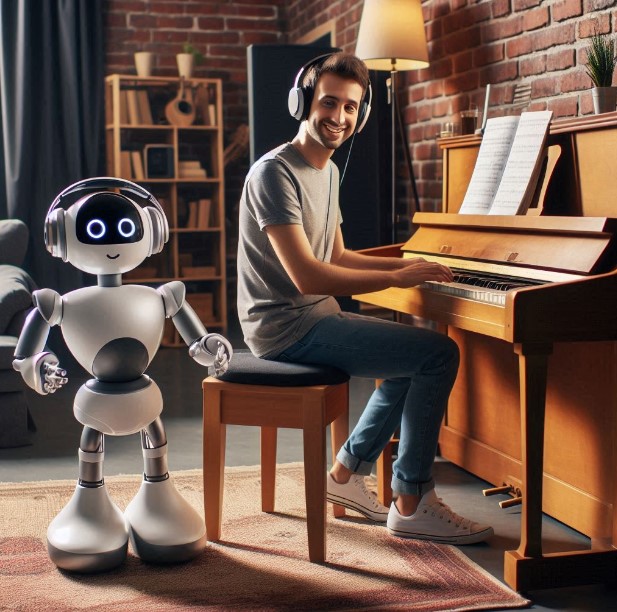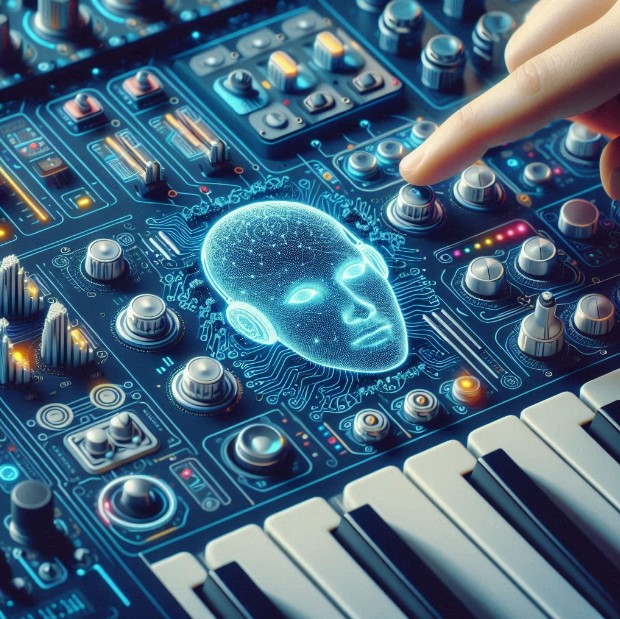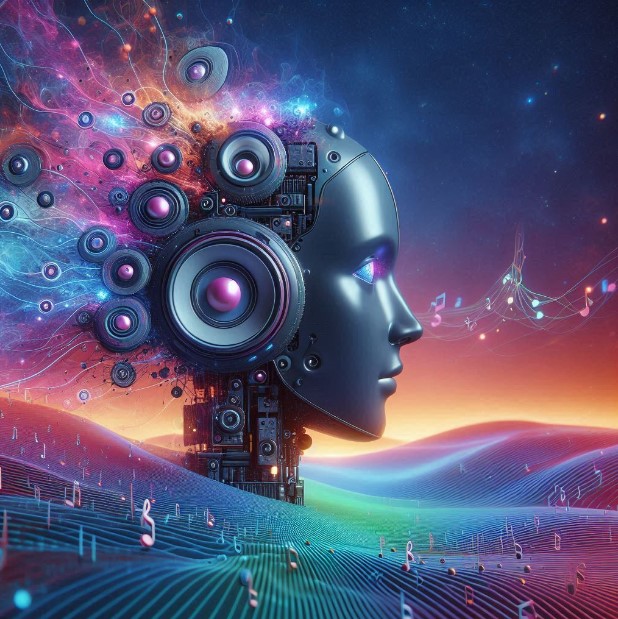Introduction
In a bustling city, an aspiring musician, Emma, found herself grappling with the urban orchestra of honking cars, distant sirens, and chattering pedestrians seeping into her makeshift home studio.
Every recording session was a battle against the intrusive noise, stifling her creativity and muddling her melodies. The frustration grew with every spoiled take, each note marred by the cacophony outside. Emma’s dream of crafting her debut album seemed to fade with every unwanted sound that crept into her tracks.
But just as her spirit dimmed, a revelation dawned; the advent of Artificial Intelligence for Audio.
AI is transforming the auditory landscape, offering solutions that can cancel out noise, improve audio codecs, and even generate original soundscapes. It brings the text to life through Text-to-Speech (TTS), and effortlessly transcribes conversations with Speech-to-Text (STT).
In the age of AI, Emma’s struggle with background noise isn’t a hindrance; it’s a challenge AI can conquer. From the depths of unwanted clamour to the heights of pristine sound, AI for Audio heralds a new era where creativity and clarity reign supreme, opening up boundless possibilities for musicians and creators everywhere.
Eradicating Unwanted Noise with AI

In the quest for pure sound, traditional noise cancellation methods have long been a staple, relying on passive techniques like insulating materials or active noise control that counteract sound waves with anti-noise. However, these methods often fall short in dynamic or unpredictable environments, unable to fully eliminate complex background noise.
Enter AI-powered noise cancellation, revolutionising the field with advanced Machine Learning (ML) and Deep Learning (DL) techniques.
Unlike traditional approaches, AI adapts to diverse and fluctuating noise patterns by analysing audio in real time. These algorithms learn to distinguish between useful audio signals and unwanted noise, continually refining their noise suppression capabilities.
AI’s adaptive learning ensures consistent clarity, making it invaluable in a variety of audio contexts.
Use Cases:
Focus on the Musician
Consider Emma, our struggling musician, who now records her guitar riffs in her urban studio. AI noise cancellation software, integrated with her recording setup, dynamically isolates her instrument’s sound from intrusive city noise. This technology identifies and filters out honks, sirens, and ambient conversations, preserving the purity of her music.
The result? Her recordings emerge with pristine clarity, free from the background clamour, allowing her to focus on the creative process of mixing and mastering her tracks without interference.
Enhance Video Conferencing
Imagine a bustling office during a virtual meeting. AI-powered noise cancellation kicks in, effortlessly suppressing background chatter and keyboard clicks.
The technology embedded in video conferencing platforms actively reduces such distractions, ensuring that participants can communicate clearly and focus on the discussion rather than the ambient noise around them. This leads to more productive meetings and a seamless exchange of ideas.
Power Up Mobile Apps
Mobile applications like advanced voice assistants and dictation tools harness AI noise cancellation to enhance user experience.
For instance, during a voice call in a noisy café, AI algorithms filter out background noise, delivering clear audio to the listener.
Similarly, dictation apps use AI to eliminate environmental noise, enabling accurate transcription of spoken words, even in less-than-ideal settings.
Data Point: Noise cancellation is on the rise! The market is expected to jump from $13.1 billion in 2019 to nearly $40 billion by 2031, growing at a healthy 13.2% clip (SkyQuest Technology, 2024). This surge highlights the increasing demand for sophisticated noise management solutions across various sectors.
AI and Audio Codecs

At the heart of our audio experiences lie audio codecs—algorithms designed to compress and decompress audio data, making it easier to store and transmit. These codecs balance reducing file size with maintaining sound quality, a crucial task in an era where digital audio pervades every corner of our lives.
Traditional codecs, though effective, have limitations. They often rely on lossy compression, which discards certain audio information to shrink file sizes. This process, while efficient, can degrade sound quality, resulting in a noticeable loss of fidelity, particularly for high-resolution audio.
AI-powered audio codecs are redefining this landscape. Leveraging Generative AI, these advanced codecs can reconstruct high-fidelity audio from compressed files. They analyse patterns in the audio data, intelligently filling in gaps left by traditional compression methods. This not only preserves the integrity of the sound but often enhances it, producing audio that closely matches or even exceeds the original quality despite reduced file sizes.
Use Cases:
Streaming Revolution
By delivering high-quality audio with significantly lower bandwidth requirements, AI-enabled audio codecs can enhance the user experience, allowing platforms to stream crisp, clear music and soundtracks even under bandwidth constraints.
For example, an AI codec can dynamically adjust the quality to ensure seamless playback without buffering, making high-fidelity streaming accessible to a wider audience.
Preserving Audio History
AI is also pivotal in restoring and enhancing older audio recordings. Historical speeches, classical music, and vintage radio shows often suffer from poor quality due to age and deterioration.
AI codecs can analyse and repair these recordings, removing noise and artefacts, and breathing new life into audio treasures from the past, ensuring that future generations can enjoy them with remarkable clarity.
GPU Acceleration
The integration of GPU acceleration is crucial in AI audio processing. GPUs boost the performance of AI algorithms, enabling real-time audio encoding and decoding. This hardware acceleration ensures that AI-powered codecs can handle complex audio tasks swiftly, making them ideal for applications that require immediate, high-quality sound, such as live streaming and interactive audio systems.
AI for Audio Generation

In the ever-evolving symphony of technology, AI for audio generation emerges as a virtuoso, crafting entirely new soundscapes and compositions with an artistry that captivates the imagination. This innovative use of AI isn’t just about replicating existing sounds—it’s about creating entirely new auditory experiences, blending creativity with algorithmic precision to produce audio that resonates on a profoundly human level.
AI audio generation employs several cutting-edge techniques to achieve its magic. One such technique is Generative Adversarial Networks (GANs). Picture two AI models in a creative duel: one generates audio samples while the other evaluates them. This competitive interaction refines the output until the generated audio becomes strikingly realistic, achieving a level of nuance and detail that mirrors human creativity.
Another groundbreaking approach is WaveNet, a deep learning model designed by Google DeepMind. WaveNet generates raw audio waveforms directly, producing lifelike sounds that are astonishingly rich and detailed. Unlike traditional models that rely on pre-defined rules, WaveNet learns from extensive datasets, enabling it to synthesise speech, music, or any audio with a natural and fluid quality.
Use Cases

1. Soundscape Design
In movies, games, and virtual reality, AI-generated soundscapes create immersive auditory environments that enhance storytelling and user engagement. For instance, in a VR forest, AI dynamically generates sounds of wind, water, and wildlife, responding to the user’s movements and creating a fully immersive sound experience that feels both authentic and magical.
Personalised Music Composition
Envision a world where your playlist is a reflection of your mood, preferences, and even your daily routines. AI-powered music generation tools analyse user data to compose personalised music, tailored to individual tastes and activities. Whether it’s an energising workout track or a soothing evening melody, AI creates compositions that resonate uniquely with each listener, making music a deeply personal experience.
Sound Effect Creation
For video games, films, and virtual simulations, AI creates bespoke sound effects that match the action perfectly—whether it’s the swoosh of a sword or the ambient sounds of a bustling cityscape. This not only enhances realism but also enriches the auditory landscape, making interactions and narratives more engaging.
AR/VR/XR Integration
Integrating AI-generated audio with Augmented Reality (AR), Virtual Reality (VR), and Extended Reality (XR) transforms interactive experiences into symphonic marvels. AI crafts responsive soundscapes that adapt in real-time, enhancing the immersion and making the virtual worlds resonate with an unparalleled sense of presence and realism.
The Power of TTS and STT

In the digital age, Text-to-Speech (TTS) and Speech-to-Text (STT) technologies are like the conductors of a symphonic dialogue between humans and machines. TTS converts written text into spoken words, which are traditionally used in applications like automated phone systems and screen readers. Conversely, STT transcribes spoken language into text, facilitating tasks such as voice dictation and command recognition. Together, they bridge textual and auditory communication, enhancing accessibility and interaction.
Advancements in AI have significantly elevated the capabilities of TTS and STT, making them more sophisticated and versatile. Natural Language Processing (NLP) plays a pivotal role in refining TTS, allowing it to generate speech that closely mimics human intonation, rhythm, and emotion. This results in a more natural and engaging listening experience, where the synthesised voice can express subtleties of speech, making digital interactions feel more lifelike.
Edge Computing enhances the performance of STT by processing data locally on devices rather than relying solely on cloud-based servers. This enables real-time, on-device transcription, reducing latency and improving responsiveness, which is crucial for applications requiring instant voice-to-text conversion.
Use Cases:
Accessibility for All
AI-powered TTS can read aloud text, converting it into clear, natural-sounding speech. This technology provides an auditory channel for consuming written information, empowering individuals to access content independently and seamlessly, thus enhancing their digital literacy and interaction.
Language Learning Revolution
Picture a traveller in a foreign country, engaging in conversation with locals. AI-powered STT translates spoken words into the traveller’s language in real time, breaking down communication barriers and facilitating language learning. By hearing and reading translations simultaneously, users can improve their language skills more intuitively and effectively.
Smart Assistants and Voice Control
Consider the interaction with smart speakers and voice assistants. AI-driven TTS enables these devices to communicate with users naturally, while STT allows them to understand and execute spoken commands. This synergy provides a seamless, voice-controlled experience, transforming how we manage our daily tasks, control smart home devices, and seek information.
Content Creation Revolution
Using AI-powered TTS, an author can generate a compelling narration of a written novel, making it accessible to a broader audience. Similarly, video creators can use TTS to add narration to their presentations, enhancing engagement and accessibility without needing professional voice actors.
Data Point: The adoption of AI-powered TTS and STT is rapidly growing,
The text-to-speech market is on a roll, expected to hit $12.5 billion by 2031, growing at a steady 16.3% annually (Allied Market Research, 2022).
Similarly, the AI speech-to-text market is booming, expected to surge from $1.98 billion in 2022 to a whopping $18.67 billion by 2032 – a growth rate of 25.3% per year (Gupta, 2024)!
What TechnoLynx Can Offer
At TechnoLynx, we are at the vanguard of the AI for Audio revolution, blending our expertise in Computer Vision, Generative AI, GPU acceleration, edge computing, Natural Language Processing (NLP), and AR/VR/XR to craft unparalleled audio solutions. We are passionate about transforming how sound is created, experienced, and enjoyed, bringing cutting-edge AI innovations to the forefront of your auditory experiences.
With TechnoLynx, you’re not just adopting new technology—you’re embracing a future where audio is more immersive, expressive, and interactive. Ready to elevate your sound? Connect with TechnoLynx today and let us help you harness the transformative power of AI for your audio needs.
Conclusion
AI for Audio emerges as a conductor of change, shaping a future soundscape rich, immersive, and boundless in its possibilities. With AI’s transformative potential, we witness a world where sound is not just heard but experienced, where creativity knows no bounds.
Looking ahead, the horizon brims with promise, as upcoming advancements promise even greater sophistication and versatility. From AI-driven sound synthesis to personalised audio experiences, the journey towards sonic excellence continues, fuelled by the relentless pursuit of innovation and the unwavering vision of a harmonious future.
Continue reading: Unlocking the Future of Music: AI in Singing
References
-
Allied Market Research. (2022, October). Text-to-Speech (TTS) Market Statistics - Industry Forecast - 2031. Allied Market Research. Retrieved June 1, 2024.
-
Gupta, A. (2024, June). AI Speech to Text Tool Market Size, Share Forecast 2032 - MRFR. Market Research Future. Retrieved June 1, 2024.
-
SkyQuest Technology. (2024, February). Noise suppression Components Market Size, Trends & Forecast - 2031. SkyQuest Technology.













